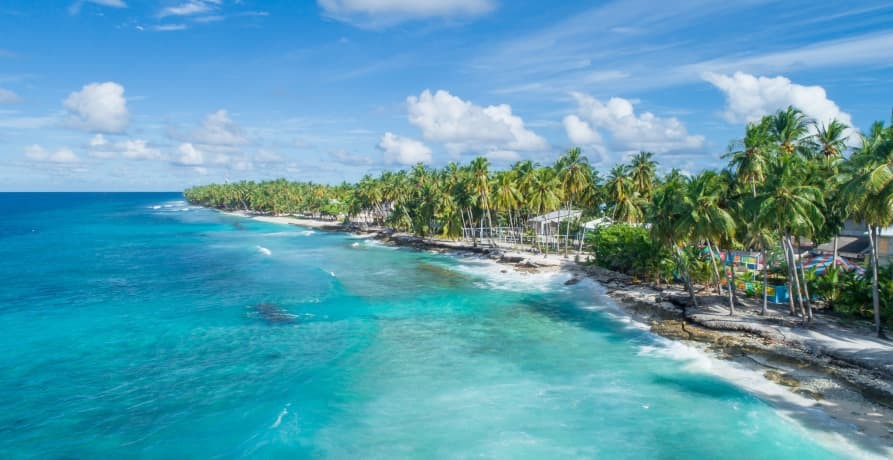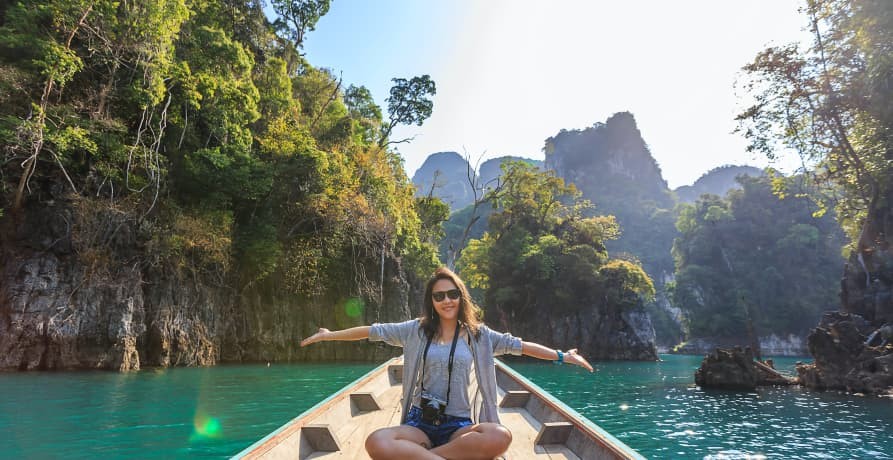Last Chance Tourism, where travelers visit destinations threatened by environmental changes, presents both opportunities and challenges for Vietnam. SIXT.VN offers convenient services to help you explore Vietnam responsibly while supporting local communities and conservation efforts. Discover sustainable travel options and make a positive impact with your journey.
1. Understanding Last Chance Tourism
What exactly is last chance tourism and why is it becoming increasingly popular?
Last chance tourism involves travelers intentionally visiting destinations vulnerable to environmental changes, especially climate change impacts. This trend has grown significantly due to increased awareness of climate change and media coverage highlighting the vulnerability of culturally and naturally significant destinations. The appeal lies in witnessing these places before they potentially change or disappear, creating a paradox where increased tourism puts additional pressure on already fragile environments.
To elaborate, last chance tourism is driven by a combination of curiosity, urgency, and a desire to witness unique locations before they are irreversibly altered. The phenomenon highlights a crucial intersection between tourism, environmental awareness, and the growing impacts of climate change. Destinations like the coral reefs in Southeast Asia, the melting glaciers of Patagonia, and the eroding coastlines of island nations are prime examples of places attracting last chance tourists. According to a report by the United Nations World Tourism Organization (UNWTO) in 2023, awareness campaigns about endangered sites have led to a 15% increase in tourist visits to these locations in the past five years. However, this surge in tourism can strain the environment, making sustainable practices vital.
2. Climate Change’s Impact on Travel Destinations
How is climate change transforming some of the world’s most beloved landscapes?
Climate change is dramatically reshaping iconic landscapes and ecosystems globally. Glaciers are retreating, sea levels are rising, and weather patterns are becoming unpredictable, altering or diminishing the unique characteristics that make these destinations appealing. These changes are not just ecological; they’re visual symbols of broader environmental shifts.
For example, the Swiss Alps are witnessing a visible retreat of their glaciers, threatening the winter sports industry that sustains many local communities. Similarly, the Great Barrier Reef in Australia is suffering from coral bleaching events due to rising ocean temperatures, impacting its vibrant marine ecosystem and drawing tourists wanting to see it before it further deteriorates. A study from the University of Queensland in 2022 indicated that over 50% of the Great Barrier Reef’s coral cover has been lost in the last three decades due to these bleaching events. These transformations underscore the urgent need for sustainable tourism practices and conservation efforts to mitigate further damage.
 Tropical Island
Tropical Island
3. The Environmental Footprint of Last Chance Tourism
What are the unintended environmental consequences of last chance tourism?
Last chance tourism often leads to significant ecological footprints in vulnerable areas least equipped to handle increased human activity. This can result in habitat disruption, pollution from transport, waste generated by tourists, and physical damage caused by the sheer volume of visitors walking on delicate land. Foot traffic in these areas can lead to soil erosion, disturb wildlife habitats, and introduce invasive species.
Specifically, the carbon emissions from air travel, a common way to reach remote destinations, exacerbate the problem. The infrastructure supporting tourists, including hotels and restaurants, also leads to increased consumption of resources, energy use, and waste. According to the International Tourism Partnership, the tourism sector accounts for about 8% of the world’s carbon emissions, with transportation being a significant contributor. Therefore, opting for sustainable transportation and accommodations can help reduce the environmental impact.
4. Balancing Conservation and Tourism: A Paradox
How can tourism both help and hurt conservation efforts in vulnerable locations?
Tourism revenue is crucial for many vulnerable sites as it often funds conservation projects. Entrance fees and guided tour costs can directly contribute to the maintenance and environmental management of these sites. However, the effectiveness of these efforts varies, and there are significant challenges in ensuring they offset the environmental impact caused by tourists.
For instance, the Galapagos Islands use tourism revenue to support strict environmental controls and scientific research, but they still face challenges from over-tourism that threaten their ecosystems. Similarly, in the Arctic, tourism funds help with polar research and wildlife conservation, but they cannot reverse the effects of global warming melting the ice caps. This leads to a paradox where tourism, while financially supporting conservation, may speed up the very destruction it seeks to prevent. Research published in the journal “Nature Sustainability” in 2021 highlights that while tourism can provide essential funding, careful management and regulation are necessary to minimize its negative impacts on sensitive environments.
 YouTube Screenshot
YouTube Screenshot
5. Economic Dependency vs. Long-Term Sustainability
Why is economic dependency on tourism a problem for long-term sustainability?
Many regions rely on tourism for economic survival, such as the Maldives, which depends on its islands and marine life. Communities near melting glaciers depend on tourists for hiking and sightseeing. However, as environments degrade, the resources that attract visitors diminish, upending local economies.
For example, coral reef degradation can lead to a drop in scuba diving tourism, a critical income source for tropical island communities. The challenge lies in balancing economic benefits with environmental costs. Increased tourism can strain infrastructure and contribute to pollution, as seen in Venice. The focus on short-term gains often overshadows the long-term environmental costs. A report by the World Bank in 2022 indicated that destinations heavily reliant on tourism need to diversify their economies to reduce vulnerability to environmental changes and fluctuations in visitor numbers.
6. Sustainable Tourism Strategies: Protecting Vulnerable Locations
What strategies can be implemented to promote sustainable tourism?
Adopting sustainable tourism strategies is crucial for protecting vulnerable tourist locations and creating a balance between visitors and the survival of the site. These strategies include:
- Limiting visitor numbers
- Implementing stricter environmental protection laws
- Encouraging eco-tourism and community-based tourism
- Diversifying the local economy
- Investing in sustainable infrastructure
For instance, Bhutan limits the number of tourists and focuses on high-value, low-impact tourism to preserve its natural environment and cultural heritage. Similarly, Costa Rica has invested heavily in eco-tourism, promoting activities that minimize environmental impact and benefit local communities. According to the Global Sustainable Tourism Council (GSTC), destinations that implement these strategies effectively can reduce their environmental footprint by up to 40% while still benefiting economically.
7. Ethical Considerations in Last Chance Tourism
What are the ethical dilemmas surrounding last chance tourism?
Last chance tourism raises awareness about climate change and the need for conservation. Tourists who witness the degradation of glaciers or coral reefs firsthand may become more motivated to engage in environmental advocacy or adopt sustainable lifestyles. However, the ethics of encouraging travel to vulnerable sites for profit, especially when such travel contributes to the damage, is contentious.
The travel industry and tourists are being forced to reconsider the sustainability of their choices. Last chance tourism needs to support conservation efforts and respect local communities, ensuring that tourism revenue contributes positively without accelerating ecological damage. Collaboration among governments, businesses, communities, and tourists is essential. Research from the University of Oxford in 2023 suggests that ethical tourism practices can enhance the visitor experience while minimizing harm to the environment and local cultures.
 Woman on a Boat
Woman on a Boat
8. Responsible Travel: A Path Forward
How can we shift towards more responsible and sustainable travel practices?
The problematic aspects of last chance tourism call for a shift towards more sustainable travel practices that prioritize environmental preservation and community welfare. This involves rethinking traditional tourism models to include sustainability as a core component. Responsible travel ensures that tourism supports conservation efforts, respects local communities, and contributes positively without accelerating ecological damage.
This shift requires collaboration among governments, businesses, communities, and tourists to develop and enforce policies that prioritize long-term environmental health over short-term gains. The United Nations Environment Programme (UNEP) advocates for integrating sustainable practices into all aspects of tourism, from transportation to accommodation and activities, to minimize negative impacts and maximize benefits for local communities and the environment.
9. Exploring Eco-Tourism and Conservation Efforts
What role does eco-tourism play in sustainable travel?
Eco-tourism represents a more sustainable way of traveling, focusing on conservation and the minimization of tourism’s negative impacts. It often involves local communities in tourism development and emphasizes the education of tourists regarding local ecosystems and conservation efforts.
For example, eco-tourism projects in the Amazon Rainforest engage indigenous guides who share their knowledge about the forest, enriching the visitor experience and ensuring that tourism benefits the local population and doesn’t harm the environment. Similarly, in Costa Rica, eco-lodges are designed to minimize environmental impact, and activities such as wildlife watching and nature walks are conducted responsibly. The International Eco-tourism Society (TIES) reports that destinations with well-managed eco-tourism initiatives can see significant improvements in biodiversity conservation and community development.
10. Regenerative Travel: Leaving a Positive Impact
How can regenerative travel help destinations recover and thrive?
Beyond sustainability, regenerative travel aims to leave destinations better than the state in which they were found. This form of tourism often involves projects that help restore environments, improve the well-being of local people, and build resilience against climate change.
Examples include reforestation projects linked to lodge stays in Africa or programs that combine coral reef restoration with scuba diving trips. In New Zealand, some tourism operators are involved in native tree planting and pest control to restore indigenous ecosystems. A study by the Adventure Travel Trade Association (ATTA) found that regenerative tourism initiatives can lead to increased community engagement, enhanced environmental conservation, and improved visitor satisfaction.
11. Voluntourism and Community-Based Tourism
What are the benefits of voluntourism and community-based tourism?
Voluntourism, where travelers take part in voluntary work, can be beneficial if well-managed and aligned with the community’s needs. Projects range from wildlife conservation efforts to teaching English or helping to build sustainable infrastructure. Community-based tourism ensures that the benefits of tourism flow directly to the community, promoting genuine cultural exchange and mutual respect.
For example, in Nepal, some voluntourism programs involve assisting with earthquake relief efforts and rebuilding infrastructure in rural communities. Community-based tourism initiatives in Peru allow tourists to stay with local families, learn about their culture, and support their livelihoods through tourism revenue. The World Tourism Organization (UNWTO) emphasizes that well-designed voluntourism and community-based tourism programs can empower local communities, preserve cultural heritage, and contribute to sustainable development.
12. Government Policies and Regulations for Sustainable Tourism
What role do governments play in promoting sustainable tourism?
Governments play an important role when it comes to making the tourism industry more sustainable. This includes enforcing environmental standards for tourism operators, establishing caps on visitor numbers to sensitive areas, and mandating environmental impact assessments for new tourism developments. Policies that encourage tourism operators to use local resources and staff can help ensure that tourism revenues benefit the local economy directly.
For instance, Palau has implemented strict environmental regulations to protect its marine environment, including banning certain types of sunscreen and limiting fishing activities. In Amsterdam, the government has introduced measures to manage tourist flows and reduce the negative impacts of over-tourism. The Organisation for Economic Co-operation and Development (OECD) highlights that effective government policies and regulations are essential for ensuring that tourism contributes to sustainable development and does not harm the environment or local communities.
13. Education and Awareness Campaigns for Travelers
Why are education and awareness campaigns important for sustainable travel?
Increasing the environmental awareness of tourists is crucial. Campaigns that educate travelers about the impacts of their actions and how they can make positive choices can help individuals to make more sustainable travel choices. Travelers who understand the challenges faced by last chance tourism destinations are more likely to respect guidelines and make decisions that contribute to conservation.
For example, the “Travel Without Trace” campaign encourages travelers to minimize their environmental impact by properly disposing of waste and respecting local ecosystems. The “Leave Only Footprints” initiative promotes responsible tourism practices in natural areas. The United Nations Educational, Scientific and Cultural Organization (UNESCO) emphasizes that education and awareness campaigns can empower travelers to become responsible stewards of cultural and natural heritage sites.
 Venice
Venice
14. Practical Steps for Sustainable Travel
How can travelers minimize their environmental impact while exploring the world?
Here are some practical steps for traveling sustainably:
- Minimize your travel carbon footprint: Choose travel options that reduce carbon emissions, such as trains over planes, direct flights, and public transportation.
- Support local economies: Engage with local businesses that practice sustainable operations, including eco-friendly accommodations and local restaurants.
- Educate yourself and others: Learn about the destination’s cultural and environmental issues and share this knowledge.
- Follow guidelines and regulations: Respect local guidelines designed to protect the environment and wildlife.
- Leave no trace: Dispose of waste properly and minimize campfire impacts.
- Participate in conservation efforts: Donate to conservation programs that work towards preserving the environment and wildlife.
For instance, travelers can choose to stay in certified eco-lodges that implement sustainable practices, such as energy efficiency and waste reduction. They can also support local farmers by buying produce at local markets. The World Wildlife Fund (WWF) encourages travelers to make informed choices that minimize their environmental footprint and contribute to conservation efforts.
15. SIXT.VN: Your Partner for Sustainable Travel in Vietnam
How can SIXT.VN help you explore Vietnam responsibly?
SIXT.VN is committed to providing convenient and sustainable travel options for exploring Vietnam. We offer a range of services designed to minimize your environmental impact and support local communities.
15.1 SIXT.VN’s Services for Eco-Conscious Travelers
What specific services does SIXT.VN offer to promote sustainable travel?
SIXT.VN provides a variety of services to help you travel responsibly in Vietnam:
- Airport Transfers: Ensure a smooth and eco-friendly start to your trip with our reliable airport transfer services.
- Hotel Booking: Choose from a selection of eco-friendly hotels that prioritize sustainability and minimize their environmental footprint.
- Tours and Activities: Discover sustainable tours and activities that support local communities and promote conservation.
- Flight Booking: Find the most efficient and eco-friendly flight options to reduce your carbon emissions.
15.2 Why Choose SIXT.VN for Your Vietnam Trip
What are the benefits of using SIXT.VN for your travel needs?
- Convenience: Easily book all your travel needs in one place, saving time and effort.
- Reliability: Count on our dependable services for a hassle-free travel experience.
- Sustainability: Support eco-friendly practices and contribute to the preservation of Vietnam’s natural beauty.
- Expert Support: Receive personalized assistance from our knowledgeable travel experts.
15.3 Sustainable Activities and Destinations with SIXT.VN
What are some eco-friendly destinations and activities you can explore with SIXT.VN?
- Eco-Tours in Sapa: Discover the stunning landscapes of Sapa with guided tours that support local communities and promote sustainable agriculture.
- Ha Long Bay Cruises: Choose eco-friendly cruise options that minimize environmental impact and support marine conservation.
- Homestays in the Mekong Delta: Experience the local culture and support community-based tourism by staying in traditional homestays.
15.4 Booking Process and Support from SIXT.VN
How easy is it to book sustainable travel options with SIXT.VN?
- Visit SIXT.VN: Start by visiting our website at SIXT.VN.
- Select Your Services: Choose from our range of services, including airport transfers, hotel bookings, tours, and flights.
- Choose Eco-Friendly Options: Look for the “Sustainable” badge to identify eco-friendly options.
- Book and Confirm: Complete your booking and receive instant confirmation.
- Enjoy Your Trip: Travel responsibly and support local communities and conservation efforts.
Our team is always available to assist you with any questions or concerns. Contact us at +84 986 244 358 or visit our office at 260 Cau Giay, Hanoi, Vietnam.
15.5 The Future of Travel with SIXT.VN
What are SIXT.VN’s future plans for promoting sustainable tourism?
SIXT.VN is committed to continuously improving our sustainability efforts. We plan to expand our selection of eco-friendly hotels, tours, and activities, and we will continue to support local communities and conservation initiatives. Our goal is to make sustainable travel the norm, not the exception, and we invite you to join us on this journey.
By adopting responsible tourism practices and considering alternatives, individuals can contribute positively to the conservation of vulnerable sites. It’s not just about seeing the world, it’s about ensuring that the world’s beauty and diversity endure for future generations.
FAQ About Last Chance Tourism
1. What is last chance tourism?
Last chance tourism involves traveling to destinations that are under threat from environmental changes, such as climate change. It is driven by the desire to see these places before they change or disappear.
2. Why is last chance tourism becoming more popular?
It is becoming more popular due to increased awareness of climate change and media coverage highlighting the vulnerability of culturally and naturally significant destinations.
3. What are the environmental impacts of last chance tourism?
The environmental impacts include habitat disruption, pollution from transport, waste generation, and physical damage caused by the volume of visitors.
4. How can tourism both help and hurt conservation efforts?
Tourism revenue can fund conservation projects, but the influx of tourists can also strain the environment and contribute to its degradation.
5. What are some sustainable tourism strategies?
Sustainable tourism strategies include limiting visitor numbers, implementing stricter environmental protection laws, and encouraging eco-tourism and community-based tourism.
6. What are the ethical considerations of last chance tourism?
Ethical considerations involve balancing the desire to witness vulnerable sites with the potential for tourism to contribute to their degradation.
7. How can travelers minimize their environmental impact while traveling?
Travelers can minimize their impact by choosing eco-friendly accommodations, supporting local businesses, and following guidelines designed to protect the environment and wildlife.
8. What is eco-tourism?
Eco-tourism is a sustainable way of traveling that focuses on conservation and the minimization of tourism’s negative impacts.
9. What is regenerative travel?
Regenerative travel aims to leave destinations better than the state in which they were found, often involving projects that help restore environments and improve the well-being of local people.
10. How does SIXT.VN support sustainable travel in Vietnam?
SIXT.VN offers services such as eco-friendly hotel options, sustainable tours, and reliable airport transfers to help travelers explore Vietnam responsibly.



